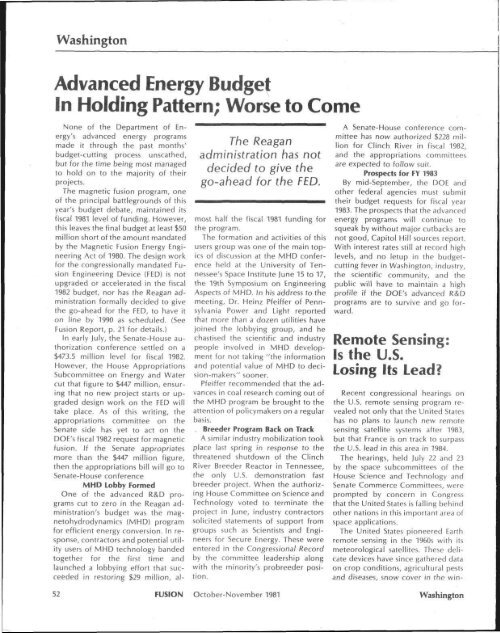Riemann's Contribution to Flight and Laser Fusion
Riemann's Contribution to Flight and Laser Fusion
Riemann's Contribution to Flight and Laser Fusion
- No tags were found...
Create successful ePaper yourself
Turn your PDF publications into a flip-book with our unique Google optimized e-Paper software.
Washing<strong>to</strong>nAdvanced Energy BudgetIn Holding Pattern; Worse <strong>to</strong> ComeNone of the Department of Energy'sadvanced energy programsmade it through the past months'budget-cutting process unscathed,but for the time being most managed<strong>to</strong> hold on <strong>to</strong> the majority of theirprojects.The magnetic fusion program, oneof the principal battlegrounds of thisyear's budget debate, maintained itsfiscal 1981 level of funding. However,this leaves the final budget at least $50million short of the amount m<strong>and</strong>atedby the Magnetic <strong>Fusion</strong> Energy EngineeringAct of 1980. The design workfor the congressionally m<strong>and</strong>ated <strong>Fusion</strong>Engineering Device (FED) is notupgraded or accelerated in the fiscal1982 budget, nor has the Reagan administrationformally decided <strong>to</strong> givethe go-ahead for the FED, <strong>to</strong> have i<strong>to</strong>n line by 1990 as scheduled. (See<strong>Fusion</strong> Report, p. 21 for details.)In early July, the Senate-House authorizationconference settled on a$473.5 million level for fiscal 1982.However, the House AppropriationsSubcommittee on Energy <strong>and</strong> Watercut that figure <strong>to</strong> $447 million, ensuringthat no new project starts or upgradeddesign work on the FED willtake place. As of this writing, theappropriations committee on theSenate side has yet <strong>to</strong> act on theDOE's fiscal 1982 request for magneticfusion. If the Senate appropriatesmore than the $447 million figure,then the appropriations bill will go <strong>to</strong>Senate-House conferenceMHD Lobby FormedOne of the advanced R&D programscut <strong>to</strong> zero in the Reagan administration'sbudget was the magne<strong>to</strong>hydrodynamics(MHD) programfor efficient energy conversion. In response,contrac<strong>to</strong>rs <strong>and</strong> potential utilityusers of MHD technology b<strong>and</strong>ed<strong>to</strong>gether for the first time <strong>and</strong>launched a lobbying effort that succeededin res<strong>to</strong>ring $29 million, al-The Reaganadministration has notdecided <strong>to</strong> give thego-ahead for the FED.most half the fiscal 1981 funding forthe program.The formation <strong>and</strong> activities of thisusers group was one of the main <strong>to</strong>picsof discussion at the MHD conferenceheld at the University of Tennessee'sSpace Institute June 15 <strong>to</strong> 17,the 19th Symposium on EngineeringAspects of MHD. In his address <strong>to</strong> themeeting, Dr. Heinz Pfeiffer of PennsylvaniaPower <strong>and</strong> Light reportedthat more than a dozen utilities havejoined the lobbying group, <strong>and</strong> hechastised the scientific <strong>and</strong> industrypeople involved in MHD developmentfor not taking "the information<strong>and</strong> potential value of MHD <strong>to</strong> decision-makers"sooner.Pfeiffer recommended that the advancesin coal research coming out ofthe MHD program be brought <strong>to</strong> theattention of policymakers on a regularbasis.. Breeder Program Back on TrackA similar industry mobilization <strong>to</strong>okplace last spring in response <strong>to</strong> thethreatened shutdown of the ClinchRiver Breeder Reac<strong>to</strong>r in Tennessee,the only U.S. demonstration fastbreeder project. When the authorizingHouse Committee on Science <strong>and</strong>Technology voted <strong>to</strong> terminate theproject in June, industry contrac<strong>to</strong>rssolicited statements of support fromgroups such as Scientists <strong>and</strong> Engineersfor Secure Energy. These wereentered in the Congressional Recordby the committee leadership alongwith the minority's probreeder position.A Senate-House conference committeehas now authorized $228 millionfor Clinch River in fiscal 1982,<strong>and</strong> the appropriations committeesare expected <strong>to</strong> follow suit.Prospects for FY 1983By mid-September, the DOE <strong>and</strong>other federal agencies must submittheir budget requests for fiscal year1983. The prospects that the advancedenergy programs will continue <strong>to</strong>squeak by without major cutbacks arenot good, Capi<strong>to</strong>l Hill sources report.With interest rates still at record highlevels, <strong>and</strong> no letup in the budgetcuttingfever in Washing<strong>to</strong>n, industry,the scientific community, <strong>and</strong> thepublic will have <strong>to</strong> maintain a highprofile if the DOE's advanced R&Dprograms are <strong>to</strong> survive <strong>and</strong> go forward.Remote Sensing:Is the U.S.Losing Its Lead?Recent congressional hearings onthe U.S. remote sensing program revealednot only that the United Stateshas no plans <strong>to</strong> launch new remotesensing satellite systems after 1983,but that France is on track <strong>to</strong> surpassthe U.S. lead in this area in 1984.The hearings, held July 22 <strong>and</strong> 23by the space subcommittees of theHouse Science <strong>and</strong> Technology <strong>and</strong>Senate Commerce Committees, wereprompted by concern in Congressthat the United States is falling behindother nations in this important area ofspace applications.The United States pioneered Earthremote sensing in the 1960s with itsmeteorological satellites. These delicatedevices have since gathered dataon crop conditions, agricultural pests<strong>and</strong> diseases, snow cover in the win-52 FUSION Oc<strong>to</strong>ber-November 1981 Washing<strong>to</strong>n
















